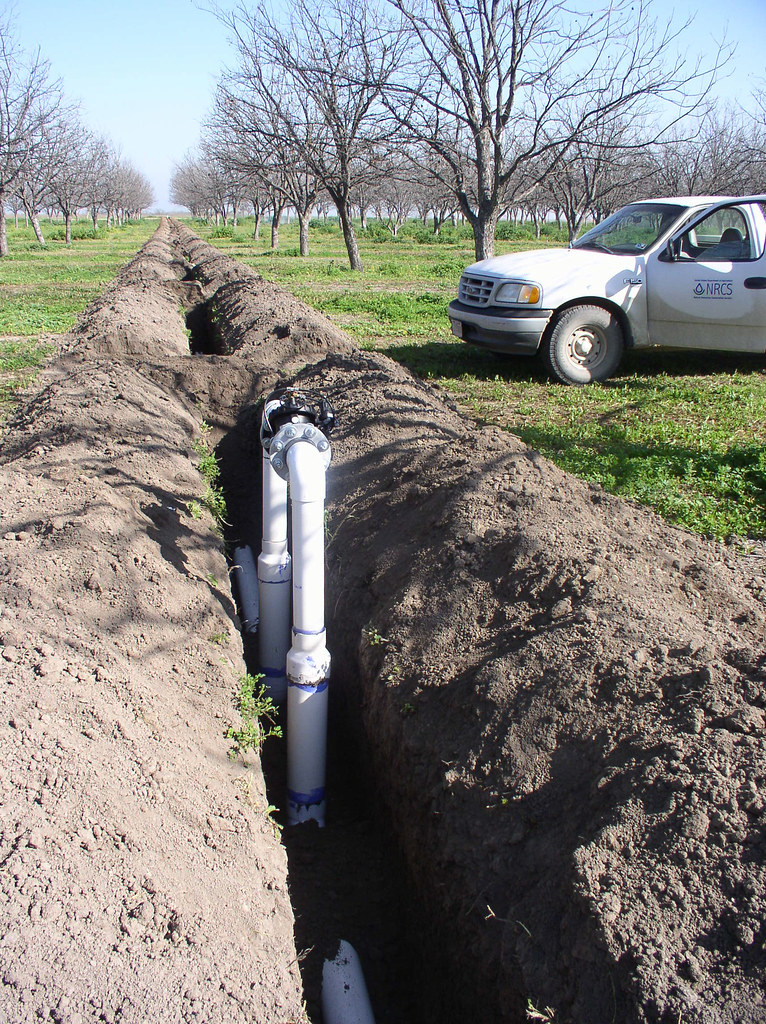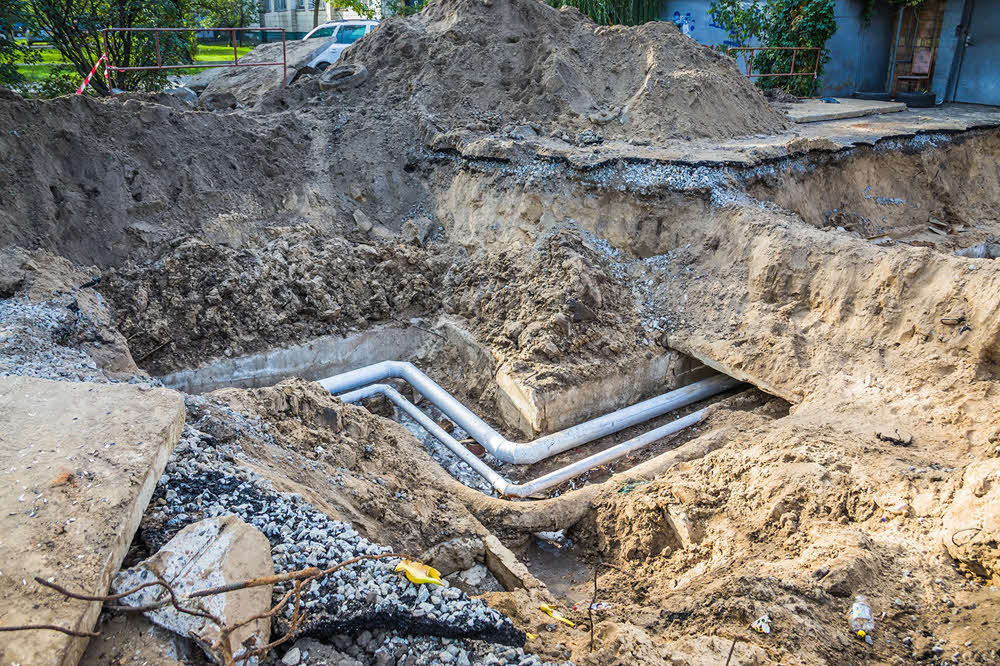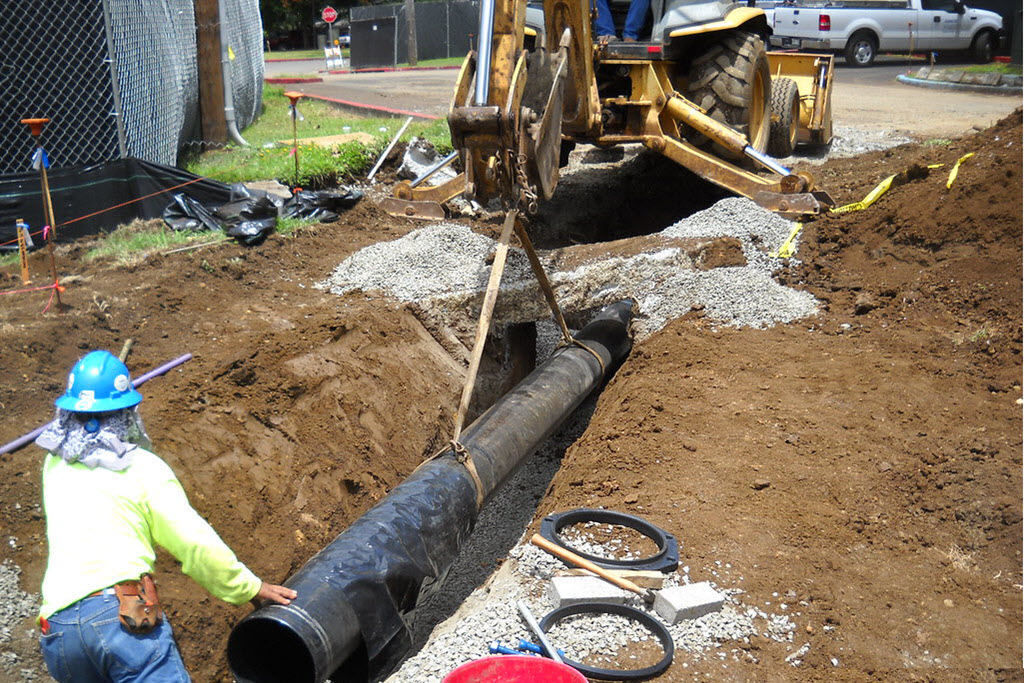Trenching Water Line Servicesin Marine City MI
Trenching for Water Lines to Ensure Reliable Water Flow
We Are Locally Owned & Operated For Over 37 Years
Contact Us Today!
We Serve Businesses In And Around The Following Cities:
About Trenching Water Line Services
Introduction
In the thriving hub of Marine City, commercial establishments have established their dominance. These structural giants, however, rely heavily on an intricate web of utilities to remain functional. One such fundamental utility that often goes unnoticed but holds paramount importance is the water line. A vast network of water lines, buried deep in the ground, supply water to commercial buildings, thereby shaping the backbone of the city’s infrastructure. This guide illuminates a vital aspect of this elaborate network— trench for the water line in commercial properties. We will unravel the process, benefits, and real-world applications of water line installation, focusing specifically on trenching methods utilized by experts such as D&J Contracting.
Understanding the Process
To appreciate the intricacies involved in installing a water service line, you must first grasp the concept of trenching. Trenching is the act of digging a long, narrow excavation in the ground for the placement of utility lines. Running a new water line in Marine City commercial properties alleges due diligence and precision, ensuring the trench is correctly sized and properly reinforced.
The process begins with marking the intended direction of the water line. It is carefully plotted to avoid interaction with other utility lines. Then, depending on the nature of the property and the surrounding soil conditions, the appropriate depth of the trench is determined. Once these prior considerations are handled, the excavation work starts. Expert services like D&J Contracting follow strict safety protocols during the operation.
Importance and Benefits of Trench
Trenching for a water line is paramount to maintaining the structural integrity of your commercial property. An adequately installed and secured trench ensures the underground water lines remain undisturbed, facilitating smooth, hassle-free water supply. Appropriate trenching also helps prevent potential mishaps like water leakage or pipe contamination.
Employing D&J Contracting for this process can garner many benefits, as they employ refined techniques, ensuring adequate soil support, frost protection, and maintaining required clearance from other utility lines. Using their trenching services minimizes the risk of water line damage — a financial and operational nightmare for any commercial establishment.
Real-World Applications
Trenching for water lines is indispensable in various commercial settings. For example, in shopping complexes, hundreds of shops rely on an uninterrupted water supply. Properly executed trenching helps in running a new water line efficiently, ensuring water reaches every corner of the premise. Similarly, large office buildings demand a seamless, abundant water supply for utilities such as bathrooms, kitchens, and fire protection systems. Here, water line installation done by professionals like D&J Contracting can make a significant difference.
In the context of eco-friendly construction, water mains installation is planned to optimize water usage, reduce leakage and contribute to greener operation. Trenching plays a vital role in such applications, ensuring the longevity and efficiency of the water lines.
Conclusion
Installing a water service line is a crucial yet often overlooked aspect of constructing and maintaining commercial properties in Marine City. It’s a multilayered task with considerable implications, balancing complex factors like soil condition, trench depth, and prevention of interference with other utility lines. A well-designed and executed trench can significantly improve both the longevity and efficiency of the water supply network.
Outfitting an expert service provider like D&J Contracting for this task can help ensure precision, adherence to safety norms, quality, and durability. Their seasoned experience brings tangible value, guiding the intricate process of trenching smoothly towards completion. Ensuring an uninterrupted, robust water supply for commercial establishments is incumbent on the careful selection of such adept, reliable service providers.
In retrospect, the integral role of trenching is irrefutable in the real-world applications we’ve discussed. It navigates the installation process, ensuring the water lines are adequately protected and efficiently supply water to the commercial buildings in Marine City. Whether you’re designing a new commercial property or managing an existing one, it’s worthwhile to consider the elements involved in trenching for water lines, embarking on the path towards a more functionally-optimized and resilient infrastructure.
Trenching Water Line Services Gallery


Call Us Today to receive your Free Quote for
Trench For Water Line in Marine City
Serving: Marine City, Michigan

About Marine City, Michigan
The area of Marine City had been Ojibwa territory for centuries before the first European contact. Beginning in the 17th century, French trappers and missionaries entered the territory, followed by settlers in the colonial period on both sides of the Detroit and St. Clair rivers. Farmers developed long, narrow plots that were laid out in the typical rectangular shape of colonial French, with the narrow end along the riverfront. The first Catholic Church was built by French Catholics at Catholic Point, where they had bought land before the United States was formed. French Canadians also lived on the other side of the river in a small farming community known as Petite Côte.
It was not until after the American Revolution that European-American settlers arrived in any number. In the 1780s they obtained a deed for land from the Chippewa Indians. The Americans began to call the community “Yankee Point”, because so many settlers came from the Northern Tier of states, with late 18th and 19th-century westward migration originating from New England and New York. They also called the settlement “Belle River” (Belle Riviere in French), as the French had; this later was applied as the name of a neighborhood.
The village was platted by Americans as Newport in 1835–37. Although never incorporated by that name, it was known as “Newport” for 31 years. In 1865, it was incorporated as the Village of Marine City. Thriving on lumber trade and shipbuilding, the village re-incorporated as a city in June 1887.
The second half of the 19th century was the period of great growth in the village, with many workers employed in the lumber and shipping industries. Rafts of lumber were moved down the St. Clair River in the spring to be worked at Marine City or Detroit. Shipyards built some of the many wooden ships that crossed the Great Lakes. Lake steamers linked passengers with small towns around the lakes. Their decks were full and their flags were flying. Marine City was centered on a park by the St. Clair River, where bands played in the bandstand at City Hall during the summer.
As the lumber business ran down with the exploitation of forests, the area became linked to other resource extraction. Freighters carried iron from Duluth, Minnesota, which had been mined in the Mesabi Range, to Ashtabula, Ohio for steel processing. They passed from Lake Superior through Lake Huron and to Lake Erie. Marine City was known as the town on the St. Clair River where the captains of lake freighters lived. Many of these men and their crews worked for the Pittsburgh Steamship Company. Formed in 1901 by US Steel Corporation, it became the largest commercial fleet on the Great Lakes.
In the 21st century, Marine City has become the home of ten antique stores. The Snug Theater is a 98-seat theater featuring live performances. It will be joined in 2014/15 by a sister theater, The Riverbank Theater, in a former bank building (originally Marine Bank & Trust) down the street. Also joining the two acting theaters is the old Mariner Theatre, which serves as a special event center, movie theater, gallery for fine art Models, and site of the builders model for the ocean-going Titanic. Restaurants and retail in downtown also cater to visitors and residents.
The Heather House, now operated as a bed and breakfast, was built in the Queen Anne Victorian-style. It was completed in 1885 after 2 years of construction for its owner, William Sauber. He was chief engineer for the Mitchell fleet of Great Lake steamers.
- According to the United States Census Bureau, the city has a total area of 2.46 square miles (6.37 km), of which 2.15 square miles (5.57 km) is land and 0.31 square miles (0.80 km) is water.
- It is considered to be part of the Thumb of Michigan, which in turn is a subregion of the Flint/Tri-Cities.
- Marine City can also be considered as in the Blue Water Area, a subregion of the Thumb.
- It is part of the Detroit-Warren-Livonia Metropolitan Statistical Area (MSA) and the Detroit-Ann Arbor-Flint Combined Statistical Area (CSA).
| Census | Pop. | Note | %± |
|---|---|---|---|
| 1870 | 1,240 | — | |
| 1880 | 1,673 | 34.9% | |
| 1890 | 3,268 | 95.3% | |
| 1900 | 3,829 | 17.2% | |
| 1910 | 3,770 | −1.5% | |
| 1920 | 3,731 | −1.0% | |
| 1930 | 3,462 | −7.2% | |
| 1940 | 3,633 | 4.9% | |
| 1950 | 4,270 | 17.5% | |
| 1960 | 4,404 | 3.1% | |
| 1970 | 4,567 | 3.7% | |
| 1980 | 4,414 | −3.4% | |
| 1990 | 4,556 | 3.2% | |
| 2000 | 4,652 | 2.1% | |
| 2010 | 4,248 | −8.7% | |
| 2020 | 4,079 | −4.0% | |
| U.S. Decennial Census | |||
As of the census of 2010, there were 4,248 people, 1,765 households, and 1,117 families residing in the city. The population density was 1,975.8 inhabitants per square mile (762.9/km). There were 2,015 housing units at an average density of 937.2 per square mile (361.9/km). The racial makeup of the city was 96.8% White, 0.3% African American, 0.7% Native American, 0.2% Asian, 0.5% from other races, and 1.6% from two or more races. Hispanic or Latino of any race were 1.7% of the population.
There were 1,765 households, of which 31.1% had children under the age of 18 living with them, 44.6% were married couples living together, 13.3% had a female householder with no husband present, 5.4% had a male householder with no wife present, and 36.7% were non-families. 31.3% of all households were made up of individuals, and 14% had someone living alone who was 65 years of age or older. The average household size was 2.41 and the average family size was 3.00.
The median age in the city was 40.2 years. 22.9% of residents were under the age of 18; 8.2% were between the ages of 18 and 24; 25.8% were from 25 to 44; 27.9% were from 45 to 64; and 15.3% were 65 years of age or older. The gender makeup of the city was 48.2% male and 51.8% female.
As of the census of 2000, there were 4,652 people, 1,860 households, and 1,212 families residing in the city. The population density was 2,120.8 inhabitants per square mile (818.8/km). There were 2,006 housing units at an average density of 914.5 per square mile (353.1/km). The racial makeup of the city was 97.29% White, 0.09% African American, 0.56% Native American, 0.26% Asian, 0.86% from other races, and 0.95% from two or more races. Hispanic or Latino of any race were 1.38% of the population.
There were 1,860 households, out of which 33.5% had children under the age of 18 living with them, 48.2% were married couples living together, 12.7% had a female householder with no husband present, and 34.8% were non-families. 30.8% of all households were made up of individuals, and 14.4% had someone living alone who was 65 years of age or older. The average household size was 2.50 and the average family size was 3.15.
In the city, the population was spread out, with 27.6% under the age of 18, 8.2% from 18 to 24, 30.5% from 25 to 44, 19.4% from 45 to 64, and 14.2% who were 65 years of age or older. The median age was 36 years. For every 100 females, there were 90.4 males. For every 100 females age 18 and over, there were 88.6 males.
The median income for a household in the city was $40,146, and the median income for a family was $47,308. Males had a median income of $39,228 versus $23,677 for females. The per capita income for the city was $19,722. About 7.6% of families and 8.9% of the population were below the poverty line, including 9.0% of those under age 18 and 16.1% of those age 65 or over.
Call Us Today to receive your Free Quote for
Trench For Water Line in Marine City
Related Services in Marine City, Michigan
We Serve Businesses In The Following Zip Codes:
48007, 48015, 48021, 48026, 48035, 48036, 48038, 48042, 48043, 48044, 48045, 48046, 48047, 48048, 48050, 48051, 48066, 48071, 48080, 48081, 48082, 48083, 48084, 48085, 48088, 48089, 48090, 48091, 48092, 48093, 48098, 48099, 48225, 48230, 48236, 48310, 48311, 48312, 48313, 48314, 48315, 48316, 48317, 48318, 48397